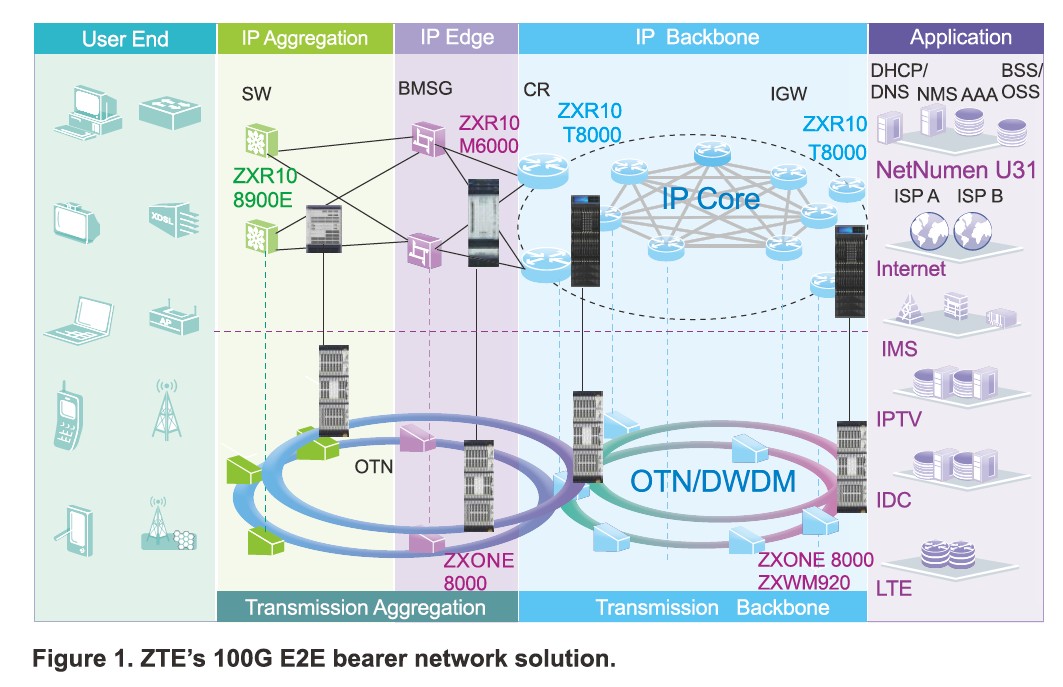100G E2E Bearer Network Solution Leads Broadband Growth
The global information explosion, high-definition videos, and cloud computing have brought about a dramatic increase in network traffic. Smoothly expanding and upgrading bearer networks has become the key to fast broadband connection. In 2010, ZTE launched the industry’s most complete 100G end-to-end (E2E) bearer network solution that converges 100G transmission, 100G routing, and 100G switching. This solution now paves the way for the development of broadband networks.

The 100G E2E bearer network solution provides ultra-high speed across the network—from convergence layer to backbone layer and from transport layer to IP layer. All three of ZTE’s high-end products for bearer network—the ZXR10 T8000100G cluster router, ZXONE 8000 large-capacity cross-connecting equipment, and the ZXR10 8900E core switch—support the 100G interfacing board. The 100G network formed by these three high-end devices and the unified network management plane significantly increase network capacity, enrich operator services, optimize network architecture, and enhance competitiveness.
By deploying ZXWM M920 and ZXONE 8000 as part of an ultra wideband 100G bearer network solution, operators can eliminate traffic bottlenecks in the core networks and meet the demand of growing data business. ZTE’s self-developed multiplexing QPSK modulation supports ultra long distance transmission of over 1000km without the need for power relays. ZTE’s proprietary core switch chip has large-capacity OTN cross-connecting based on ODU2/ODU3/ODU4 granules. This provides flexible traffic scheduling for core nodes. The 100G E2E bearer network supports, at most, a ten-dimensional ROADM system. It uses the WASON intelligent control plane to greatly shorten the time for service deployment and provides multiple recovery paths for key services. It also supports hybrid transmission of 40G/100G. Operators can simply upgrade the circuit-side single board of their existing platform to support 100G. This reduces networking costs and protects network investment.
The E2E 100G bearer network uses ZXR10 T8000 in the backbone IP layer, which creates a super node and allows for smooth evolution from 10G to 100G. The telecom-class 100G routing cluster system, ZXR10 T8000, has the largest capacity in the industry. By using the virtual cluster control technique, a cloud computing-based control plane, and high-performance chips, ZXR10 T8000 can support a maximum of a 16+64 multi-chassis system and 200T switching. The highly-integrated 40G/100G chipsets with low power consumption provide end-to-end high-speed bearer channels that reduce transmission cost per bit. ZXR10 T8000 operates on ZXROS—ZTE’s self-developed operating system. ZXROS has a modular, process-oriented, micro-kernel software platform that implements hot patching, non-stop routing, online component upgrading, and online cluster upgrading through dynamic process loading. These O&M tasks are completed without affecting user service experience.
In the convergence access layer, the solution uses a ZXR10 8900E core switch that has the first 100G port in the industry. The new-generation ultra wideband core switch is based on ZTE’s multidimension secure switching architecture and a fully distributed OS platform. It provides ultra high-speed 40G and 100G Ethernet interfaces as well as a 480GB single board that is currently the highest in the industry. ZXR10 8900E supports a full range of customized solutions, including complete Ethernet, MPLS, multicast services, and advanced MAN bearer platform. It supports IEEE 1588v2 and synchronous Ethernet (for future convergence of bearers), advanced deep packet inspection and security control, and multidimensional core convergence platform. It also supports virtualization, FCoE and virtual cluster switching so that a future cloud-based bearer platform can be built.
In the network management layer, ZTE’s NetNumen U31 unified network management system is used for centralized management, fast end-to-end scheduling, and comprehensive monitoring of services offered. With efficient and stable advanced system architecture, the modular structure of components is easy to expand and maintain. NetNumen U31 also provides a complete security solution to ensure system security and reliability.
ZTE has been promoting the development and commercialization of 100G standards in the industry. They have been heavily involved in drafting proposals for IEEE 100GE, ITU-T 100G ODU4, and OIF 100G WDM. ZTE has mastered core technologies such as large-capacity photoelectric switching, 100G message processing, 100G MAC, 100G OTN packaging, and 100G wavelength-division multiplexing. They have good strategic partnerships within industry circles.
ZTE’s routers, switches, IPTN, and OTN/WDM products fully support a 100GE interface. ZTE’s long-distance transmission equipment supports a 100G line interface and large-capacity electric cross-connecting. While implementing high-performance 100G, ZTE strives for functional completeness, user friendliness, and low-power consumption. Cost-efficient bearer network solutions allow operators to smoothly upgrade their networks and use one-stop 100G services.
The 100G industrial chain is being developed and has not yet matured. 100G and 40G are technologies of the same period. The technical complexity of 40G is a little less than that of 100G, and the port density of 40G can be 2-3 times higher than in 100G equipment. A mature 40G industry will be established soon to meet pressing application needs in the market. 40G is a practical transition technology that will coexist with 100G in the long term. The 100G WDM industry is being gradually improved. Because of different bandwidth requirements and development strategies between operators, different economic development between countries and regions, and different network levels, 40G and 100G will coexist in the long term. In general, 100G will gradually dominate in the trunk and 40G will be used more in MAN areas.
In 2011, the 100G market is expected to remain in the testing and trial stage, on the verge of large-scale application. ZTE will participate with key operators to test and trial 100G WDM and 100G routing and will continue to improve their product features and solutions. This will lay a good foundation for marketing the products for later large-scale application.
Another requirement for developing 100G technology is enhancing the port density of 40G and 10G. Good solutions can be provided only by combining the two. In 2011, ZTE will launch more products with high-density 10G and high-density 40G to enhance its competitiveness in the 10G/40G era. These products will also allow ZTE to smoothly transition into the 100G application environment.